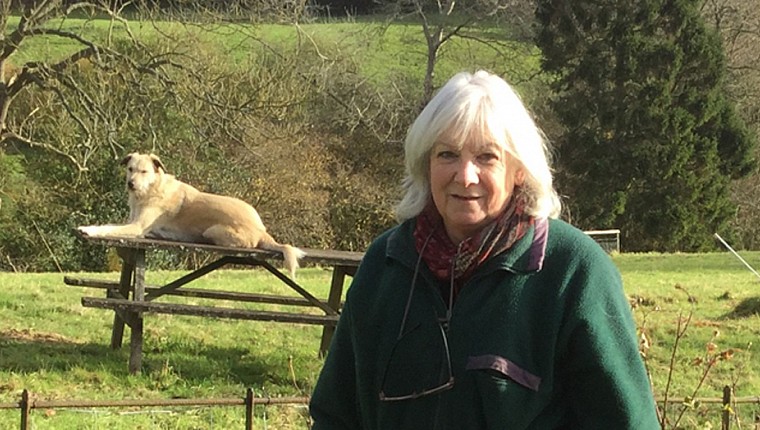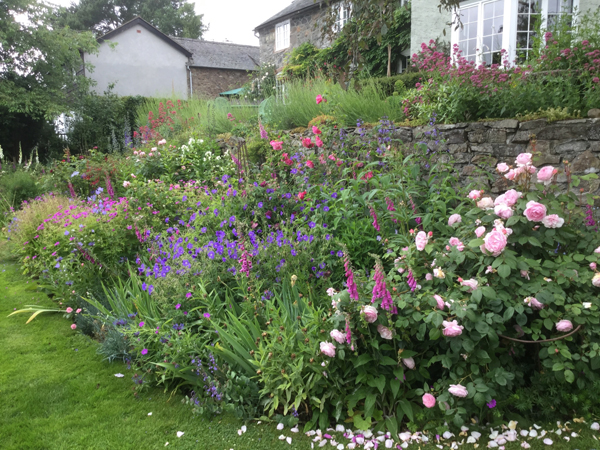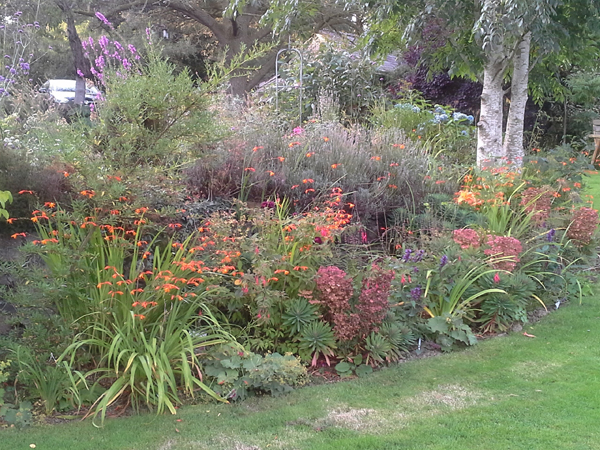How I finally embraced Autumn and learned to love orange

Annie Frost, owner of the beautiful two-acre garden, Gorsty House in Powys, tells us all about her turbulent relationship with orange – and how embracing the colour means she can now enjoy her garden’s glorious last hurrah of the year.
“I have never liked orange in the garden. Yellow either, come to that, past that wonderful, first, life-enhancing explosion in the spring. Yellow is fine if it remembers its place. No, for me, my soul finds peace in those gentle hues of early summer: pinks, blues of every shade, lavender. Purple is wonderful. White. Even red, as long as it is that beautiful deep blood red, or bruised plums, or the light through a good bottle of burgundy. But not orange. Never orange. My late mother-in-law loved orange. We would go to the garden centre or garden visiting, and her eye would alight on some vivid, showy orange flower, and she’d head straight for it. “Oh, isn’t that beautiful?” she’d breathe, and I’d offer a stiff, polite smile and move on to something far more tasteful. My garden abounded with those beautiful muted, smoky colours, and I would sigh contentedly. There was, however, a very obvious problem, and one that gardeners who share my bias will recognise. By the end of June, it was all pretty much over. Not completely of course. There are obviously purples and blues and pinks that run into the autumn and the roses will continue to bloom, but it’s not the show-stopping extravaganza of early summer. If you love green, you’ll be very content, but if you need a bit more to make your heart sing, you’re in trouble. Like many a gardener before me, I bemoaned the situation. I tried to be content, but I was painfully aware that things could and should be different.

Gorsty House in the Summer
“For many years I worked in a small family run plant nursery, so it should have been easy. I rarely took wages home; as soon as I was paid, I made a rapid exchange for plants, and there was plenty of choice. Unfortunately, as the year progressed, the colour palette changed, and my dilemma returned. The soft colours started to disappear, and something altogether more forceful started to take centre stage. I didn’t like it one little bit.
“The turning point came when I moved to the house I now live in, and a couple of things happened. The garden appeared to be that wonderful prize, ‘a blank canvas’. I inherited just over two acres of land, an acre of which was an untended meadow, and the remainder consisted of course grass, nettles, brambles, and self-sown saplings. Someone had obviously loved the garden once. The ghost of it lay under the neglect, like a glint in the eye of an elderly maiden aunt at a family party. The hard landscaping was there, lots of mature trees, a ‘secret garden’ behind an overgrown beech hedge. There were very few plants though. A few straggly rose bushes, some leggy azaleas lying horizontally across the grass, and a few as yet unidentified leaves struggling through the weeds, indicating areas where borders might once have bloomed.

“In that first spring, something became apparent: whoever this mysterious gardener had been, they loved orange. If an orange variety of anything existed, they had bought it. If they couldn’t get orange, yellow would do. I was appalled, and my first reaction was rapid removal. The first casualty was a particularly vivid floribunda rose. It was a poor specimen anyway, and I couldn’t live with it. It went. The other couple of roses were a less offensive shade of yellow, the form was attractive, and the scent delicious, so they were given at least a temporary reprieve. I found the azaleas, on the whole, stomach churning. One was a particularly lurid orange, but much admired by a neighbour, and it was carefully rehomed. A second one seemed undecided about where on the colour wheel it belonged – it was neither quite orange nor yellow, but unpleasant in either section. During the process of trying to raise it to the vertical, the trunk snapped, so that particular problem was solved. The remaining one was interesting. It had two colours growing from the same base. One was an insipid coral, which managed to clash horribly with the other side, presumably the original rootstock; but that turned out to be Azalea lutea, with a stunning scent that drifted for long distances across the garden. The coral section was incised, and the rest allowed to remain.

“The plant struggling through the undergrowth, however, was worse. It was crocosmia. The bog standard one, and lots of it. Now, if you’ve ever grown crocosmia, you will know that it’s as pernicious as any weed, and nigh on impossible to eradicate. I started doing a weekly dig, and never failed to unearth lots of little bulbs that ran like strings of pearls through the soil. I was distraught.
“At that point, a second thing happened. A kindly neighbour, aware that I had a huge empty space to fill, started bringing me plants. And among the first things to arrive was a day lily. Orange. Not that vivid, migraine-inducing shade that had me reaching for the sunglasses however, but a rather lovely, soft, burnt orange. I had to admit it. I really rather liked it. I took stock of the layout of the garden, and I started digging a bed in front of the wall where the offending crocosmia lurked. I added the day lilies, and a large red fuchsia that I’d removed from another area of the garden. I added some English roses; the maroon Falstaff, the stunning deep blood red Munstead Wood, and the curious burnt orange Summer Song. I added some deep purple agastache and salvias, and some lime green euphorbia. And do you know what? It was stunning.

“I haven’t looked back. I still can’t tolerate that vivid toxic orange that appears to contain too many E numbers, and can cause a nervous reaction. But copper, apricot, peach, even soft tangerine, are all welcome. Not everywhere , but in enough of the garden to ensure that as I write this, in early October, the borders still blaze with colour. I have learned that colour combinations are more important than the colour itself, and that planted alongside the right partner, pretty much anything goes. Purple, for example, goes with anything. Really. There are michaelmas daisies of every hue rudbekias, heleniums, sedums, kniphofia, deep maroon and orange dahlias, all part of the glorious last hurrah of late summer.
“But there’s no need to stop there. I’m browsing the catalogues for spring bulbs, and the tulips are incredible. They come in a wonderful, exuberant, almost (unless you’re looking for blue) range of colours – including just about every shade of orange. Well, how could anyone possibly garden without it…?”


















